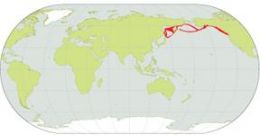Pollock (lat. Theragra chalcogramma, eng. Alaska pollock)— benthic-pelagic cold-water fish of the cod family. The most common fish in the North Pacific ocean. Along with Atlantic blue whiting, Pacific Pollock were previously regarded as a resource a small nutritional value. Along with other pelagic predators (mackerel, cod, tuna, mackerel) finds nourishment at different trophic levels.
What is hidden under the trade name. Pollock (Theragra chalcogramma) – fish of the cod family.
 Recommendations to consumers. The population of Pollock, the most common fish in the far East, are in a stable condition, besides a fairly short life cycle allows this kind in the case of overfishing, quickly restore strength. The impact of Pollock fisheries on the ecosystem is relatively small, although there is bycatch of salmon and marine mammals, but it is not yet known. Now fisheries for Pollock in the far Eastern seas are certified according to the standards of the Marine stewardship Council (MSC), and the American “mincepie” fisheries are already certified.
Recommendations to consumers. The population of Pollock, the most common fish in the far East, are in a stable condition, besides a fairly short life cycle allows this kind in the case of overfishing, quickly restore strength. The impact of Pollock fisheries on the ecosystem is relatively small, although there is bycatch of salmon and marine mammals, but it is not yet known. Now fisheries for Pollock in the far Eastern seas are certified according to the standards of the Marine stewardship Council (MSC), and the American “mincepie” fisheries are already certified.
Care should be taken to treat the fillets so-called “secondary freeze” fish, which is caught and frozen in the Barents and far Eastern seas, transported for reprocessing in Southeast Asia, again frozen and then shipped to market. Try to find a fillet primary frosts.
It’s fun! Catches of Alaska Pollock is now second only to the catches of the Peruvian anchovy, and during spawning in some places the number of eggs may reach 30 thousand eggs under one square meter of the ocean surface.
 Among trnkobrani fishes of the World ocean Pollock is a leader in production volume. In the mid-1980s, global catches of Pollock reached almost 7 million tonnes, Half of the catch was contributed by the former USSR and China. In the 1990-ies catches did not exceed 5 million t, and in the beginning of the third Millennium fell to 2.5 and 2.9 million tons due to overfishing of Alaska Pollock existence is under serious threat, so Greenpeace has called in the autumn of 2009 to refrain from the purchase and consumption of Alaska Pollock and its products.
Among trnkobrani fishes of the World ocean Pollock is a leader in production volume. In the mid-1980s, global catches of Pollock reached almost 7 million tonnes, Half of the catch was contributed by the former USSR and China. In the 1990-ies catches did not exceed 5 million t, and in the beginning of the third Millennium fell to 2.5 and 2.9 million tons due to overfishing of Alaska Pollock existence is under serious threat, so Greenpeace has called in the autumn of 2009 to refrain from the purchase and consumption of Alaska Pollock and its products.
Among EU countries the largest importers of Alaska Pollock from Russia and China are Germany, France and the UK. In 1996 about 95% of Alaska Pollock imported to the EU, was addressed mainly in these three States.
In 2015, the catch of Pollock reached 1,623 thousand tons that is by 6.9% more than in 2014. Of the 1.8 million tons of Russian exports of fish products, is the leader Pollack frozen, the volume of supply has reached 770 thousand tons, an increase of 10.5% compared to 2014.
Biology. Pollack lives at depths of 500-700 m, but for spawning fish closer to the shores, to depths of 50-100 m. Spawning occurs in winter or spring. The ROE floats in the water column, hatching larvae grow rapidly. Throughout his life, Pollock feed on plankton. Pollock Matures in 3-4 years. Usually the length of Pollock is 20-50 cm and weight about 1.5 kg, although some individuals can reach a length of 93 cm and a weight of 5 kg.
Fisheries/aquaculture. Catches of Alaska Pollock are very high and amount to 2-4 million tons per year. Caught this fish mainly Russia, China, Japan, Canada and the United States, with most of the fish caught during the spawning period, when she has caviar, which is highly valued in the Japanese market. Pollock forms dense clusters, almost does not contain other types of fish. Therefore, bycatch of other species while fishing for Pollock is insignificant, and the use of midwater trawls, in most cases, does not cause significant damage to benthic communities.At the same time in the far East overfished and the destruction of juveniles of this species in winter, when it is caught primarily for the eggs.
Pollock sold in chilled, frozen and filterbanks, in the form of meat. Popular as eggs and liver Pollock. The so-called “crab sticks” are also mainly made from Pollock or hake.
Leave a Reply
Be the First to Comment!